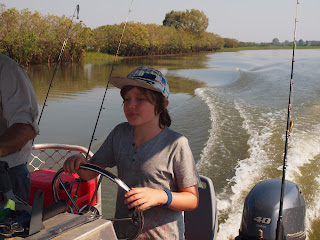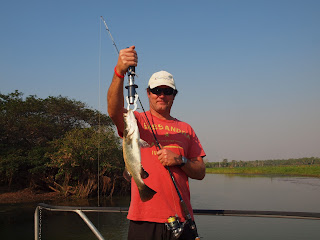I have wanted to visit Uluru for so long that I nearly started crying when we finally saw it in the landscape. It is a beautiful and amazing place.
Things you need to know if you are planning to visit:
It is worth making a phone call to book a few days in advance if you want power: There is only one place you can stay - Ayres Rock Resort, Yulara. Within the resort there are several hotels, units and of course the caravan park where we stayed. We had not booked, as we hadn't needed to for most places, so we spent the next three nights in the "overflow area" with a few hundred other people. There were no powered sites left for caravans, camper trailers and other accomodation that uses vehicles. There were heaps of powered tent sites available. The site was actually fine for us as we were set up to be self sufficient without power, and it only cost us $15 a night! The only problem was it was a bit of a hike from the toilet, which is fine, until you need to pee at 4.30 in the morning! We also found that the solar powered showers in the park were only warm enough to shower under if you showered during sunlight hours - which kind of sucked on the first night when I found this out the hard way. It probably didn't help that we arrived on the Friday night, when the school holidays started. It was also a long weeeknd for Territory Day!
Beer - the cheapest option, a six pack of Melbourne Bitter, cost $39.90 in the resort. Best to BYO!
Fuel - Diesel was $2.05 per litre at Yulara, which was cheaper than Curtin Springs down the road @ $2.34/l. Take extra fuel like we did and you might be able to get to Erldunda and fill up for $1.93/l.
There are so many people there it is hard to find a quiet spot to enjoy the spirituality of the place.
Uluru
The land around Uluru is so flat that its immense presence in the landscape holds a power over you as you approach it. You can understand why it is such an important spiritual place to the Anangu people.
Entry to the park is $25 per person over 15 (children and NT residents free) for three days. You can only pay at the entry gate. The park opens very early but does change depending upon the time of year, taking into consideration sunrise, sunset and daytime temperatures. Sunrise was at 7.30ish so we had to leave the caravan park around 6.30. It was very cold (I was going to say "freezing" but then I remembered what all my friends and family in Canberra have been experiencing in the mornings and decided to pull back a bit!) This first photograph is as we are driving around to the sunrise viewing area. You actually have to drive what feels like almost the whole way around the rock before you can find the viewing area.



These next few photos are from the Mala walk. We took the free ranger guided walk with about 40 or more other people, hearing the traditional story that applies in this area and learning how some of the areas were and are used by Anangu people. It was fascinating. Of course, we only heard the "kids" version of the story as you are not able to hear more layers of the story until you have spent considerable time living and learning in the area. We didn't bother taking any photos until we were on our way back. We waited until most of the others moved on.
 |
You can see the black mark where, after rain, water flows down to fill the waterhole in the area behind me.
The water in this waterhole used to be drinkable but over time as more people have visited/climbed on Uluru the water has become toxic to humans and other animals. |
Around the base of Uluru, erosion has created these amazing rock waves which provide shelters and each shelter serves a different purpose. Some are cooking areas, classrooms and others ceremonial areas.
 |
| Don't climb Uluru! |
The Uluru climb is still open, despite Anangu requests that people don't climb it. This is as a result of the agreement that had to be signed when the land was handed back to the Anangu people. This meant leasing the land back to the government (99 year lease) and keeping the climb open. Being such an icon I guess it draws tourism from all over Australia and around the world. It is very political. It is hoped that the government will agree to close the climb within a few years. I was disappointed with the number of people who did the climb and the poor attitude some people have to respecting other people's cultures. However, I suspect there were many more who did not climb for each person that did.
Three reasons not to climb:
respect for culture/religion
environmental considerations (erosion, pollution - rubbish and toileting)
personal safety
Kata Tjuta
You can see Kata Tjuta from Uluru although it is a 50km drive to get there. Liam's favourite thing about it was a big rock that well...looked kind of like a bum...so we named it bum rock! Then when we got there we realised there were two walks you could do, Walpa Gorge and Valley of the Winds. You can imagine the laughs we had. Liam suggested that Andy Griffith's, author of The Day My Bum Went Psycho etc, would love it! We had to settle down though and be quiet and respectful.
 |
| Walpa Gorge |
 |
| Valley of the Winds |
 |
| Valley of the Winds |






























































